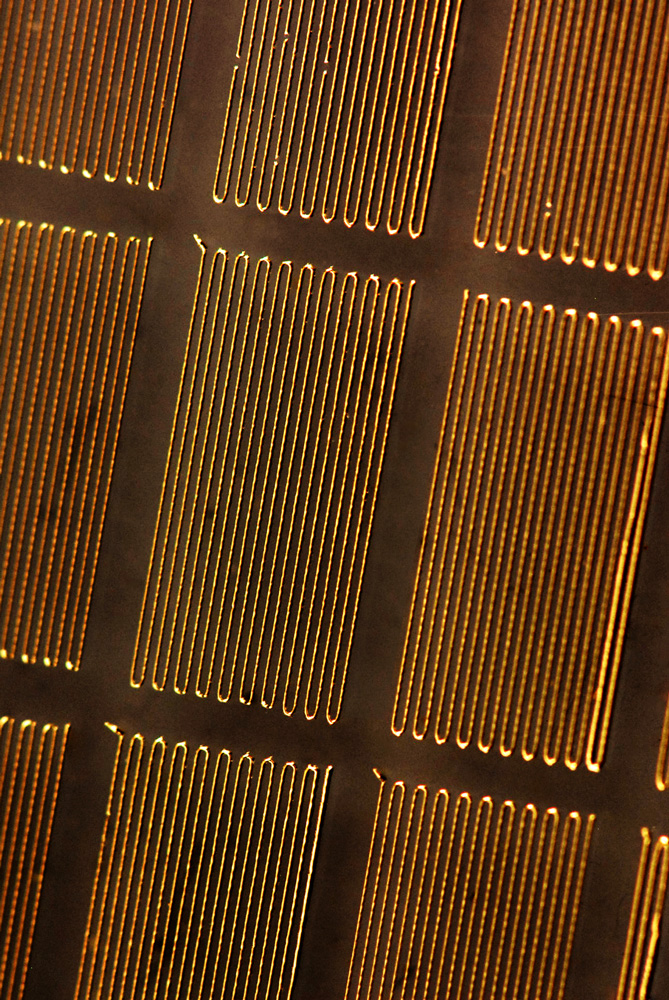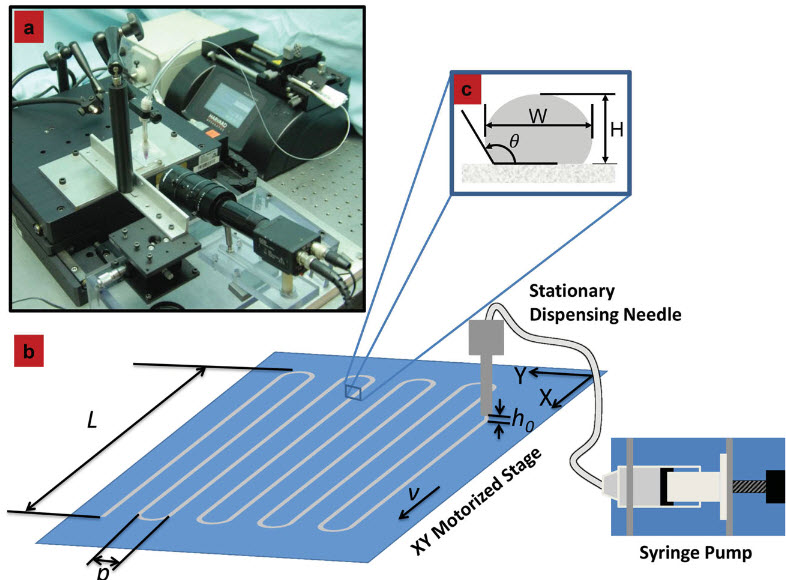How to create ‘soft’ machines
July 10, 2014

Purdue researchers have developed a technique to embed a liquid-alloy pattern inside a rubber-like polymer to form a network of sensors. The approach might be used to produce “soft machines” made of elastic materials and liquid metals for potential applications in robotics, medical devices, and consumer electronics. (Credit: Rebecca Kramer/Purdue University)
Purdue University researchers have developed a technique that could be used to create “soft machines” made of elastic materials and liquid metals for robotics, medical devices, and consumer electronics.
Think robots with sensory skin, or stretchable garments that let you interact with a computer, or for therapeutic purposes.
Rebecca Kramer, an assistant professor of mechanical engineering and her research team have used the technique to create strain gauges, which measure how much something is stretching.
The researchers embedded liquid-alloy devices into a rubber-like polymer called polydimethylsiloxane, or PDMS, a silicon-based “elastomer.” The liquid gallium-indium alloy was used to create patterns of lines to form a network of sensors.
“It has some odd properties,” Kramer said. “Gallium oxidizes really quickly and forms a thick gallium-oxide skin, which is challenging to work with using typical liquid-processing techniques.”
However, the Purdue researchers have invented a method that takes advantage of the alloy’s oxidized skin. “We exploit this oxide skin by using it for structural stability. This means you can print liquid on a surface and it will maintain stable structures without moving around,” she said.
“Once you print it you can flip it over or turn it on its side, because the liquid is encased by this oxide skin. We use this finding to embed our electronics in elastomer without ruining or altering the printed structures during the processing steps.”
Strain gauges measure how much a material stretches or deforms. Because conventional strain gauges are made of rigid metal film, they can’t measure more than a 1-percent deformation before breaking, whereas a soft strain gauge could continue stretching with the material, measuring 100 percent of a material’s strain.

Direct writing system. (a) Photograph of direct writing system; (b) Schematic of direct writing system writing a serpentine pattern. (Credit: J. William Boley et al./Advanced Functional Materials)
The findings are detailed in a research paper appearing in the journal Advanced Functional Materials, which describes how to use the 3D printer to create soft strain gauges.
The new process also can be used to fabricate pressure sensors, capacitors, and conductors. Previously, Kramer developed a hyperelastic tactile keypad using the same materials. “It’s a sensitive keypad that is flexible and wearable,” she said. “When you push on the elastomer it will deform the underlying microchannels, changing the resistance across them.”
Soft machines could make possible new types of soft microelectromechanical systems, or MEMS. Current MEMS such as miniature accelerometers and gyroscopes found in consumer electronics, automotive airbags and other products are made of solid metals. However, the development of soft MEMS could open up new applications.
Abstract of Advanced Functional Materials paper
In this paper, a direct writing method for gallium-indium alloys is presented. The relationships between nozzle inner diameter, standoff distance, flow rate, and the resulting trace geometry are demonstrated. The interaction between the gallium oxide layer and the substrate is critically important in understanding the printing behavior of the liquid metal. The difference between receding and advancing contact angles demonstrates that the adhesion of the oxide layer to the substrate surface is stronger than the wetting of the surface by the gallium-indium alloy. This further demonstrates why free-standing structures such as the traces described herein can be realized. In addition to the basic characterization of the direct writing process, a design algorithm that is generalizable to a range of trace geometries is developed. This method is applied to the fabrication of an elastomer-encapsulated strain gauge that displays an approximately linear behavior through 50 percent strain with a gauge factor of 1.5.